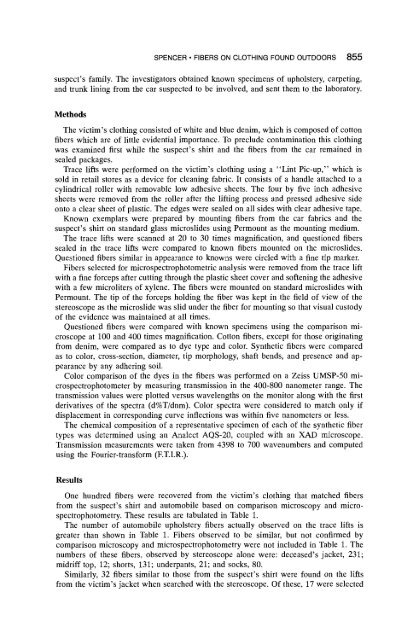Significant Fiber Evidence Recovered from the Clothing of a - Library
Significant Fiber Evidence Recovered from the Clothing of a - Library
Significant Fiber Evidence Recovered from the Clothing of a - Library
Create successful ePaper yourself
Turn your PDF publications into a flip-book with our unique Google optimized e-Paper software.
SPENCER ~ FIBERS ON CLOTHING FOUND OUTDOORS 855<br />
suspect's family. The investigators obtained known specimens <strong>of</strong> upholstery, carpeting,<br />
and trunk lining <strong>from</strong> <strong>the</strong> car suspected to be involved, and sent <strong>the</strong>m to<strong>the</strong> laboratory.<br />
Methods<br />
The victim's clothing consisted <strong>of</strong> white and blue denim, which is composed <strong>of</strong> cotton<br />
fibers which are <strong>of</strong> little evidential importance. To preclude contamination this clothing<br />
was examined first while <strong>the</strong> suspect's shirt and <strong>the</strong> fibers <strong>from</strong> <strong>the</strong> car remained in<br />
sealed packages.<br />
Trace lifts were performed on <strong>the</strong> victim's clothing using a "Lint Pic-up," which is<br />
sold in retail stores as a device for cleaning fabric. It consists <strong>of</strong> a handle attached to a<br />
cylindrical roller with removable low adhesive sheets. The four by five inch adhesive<br />
sheets were removed <strong>from</strong> <strong>the</strong> roller after <strong>the</strong> lifting process and pressed adhesive side<br />
onto a clear sheet <strong>of</strong> plastic. The edges were sealed on all sides with clear adhesive tape.<br />
Known exemplars were prepared by mounting fibers <strong>from</strong> <strong>the</strong> car fabrics and <strong>the</strong><br />
suspect's shirt on standard glass microslides using Permount as <strong>the</strong> mounting medium.<br />
The trace lifts were scanned at 20 to 30 times magnification, and questioned fibers<br />
sealed in <strong>the</strong> trace lifts were compared to known fibers mounted on <strong>the</strong> microslides.<br />
Questioned fibers similar in appearance to knowns were circled with a fine tip marker.<br />
<strong>Fiber</strong>s selected for microspectrophotometric analysis were removed <strong>from</strong> <strong>the</strong> trace lift<br />
with a fine forceps after cutting through <strong>the</strong> plastic sheet cover and s<strong>of</strong>tening <strong>the</strong> adhesive<br />
with a few microliters <strong>of</strong> xylene. The fibers were mounted on standard microslides with<br />
Permount. The tip <strong>of</strong> <strong>the</strong> forceps holding <strong>the</strong> fiber was kept in <strong>the</strong> field <strong>of</strong> view <strong>of</strong> <strong>the</strong><br />
stereoscope as <strong>the</strong> microslide was slid under <strong>the</strong> fiber for mounting so that visual custody<br />
<strong>of</strong> <strong>the</strong> evidence was maintained at all times.<br />
Questioned fibers were compared with known specimens using <strong>the</strong> comparison mi-<br />
croscope at 100 and 400 times magnification. Cotton fibers, except for those originating<br />
<strong>from</strong> denim, were compared as to dye type and color. Syn<strong>the</strong>tic fibers were compared<br />
as to color, cross-section, diameter, tip morphology, shaft bends, and presence and ap-<br />
pearance by any adhering soil.<br />
Color comparison <strong>of</strong> <strong>the</strong> dyes in <strong>the</strong> fibers was performed on a Zeiss UMSP-50 mi-<br />
crospectrophotometer by measuring transmission in <strong>the</strong> 400-800 nanometer range. The<br />
transmission values were plotted versus wavelengths on <strong>the</strong> monitor along with <strong>the</strong> first<br />
derivatives <strong>of</strong> <strong>the</strong> spectra (d%T/dnm). Color spectra were considered to match only if<br />
displacement in corresponding curve inflections was within five nanometers or less.<br />
The chemical composition <strong>of</strong> a representative specimen <strong>of</strong> each <strong>of</strong> <strong>the</strong> syn<strong>the</strong>tic fiber<br />
types was determined using an Analect AQS-20, coupled with an XAD microscope.<br />
Transmission measurements were taken <strong>from</strong> 4398 to 700 wavenumbers and computed<br />
using <strong>the</strong> Fourier-transform (ET.I.R.).<br />
Results<br />
One hundred fibers were recovered <strong>from</strong> <strong>the</strong> victim's clothing that matched fibers<br />
<strong>from</strong> <strong>the</strong> suspect's shirt and automobile based on comparison microscopy and micro-<br />
spectrophotometry. These results are tabulated in Table 1.<br />
The number <strong>of</strong> automobile upholstery fibers actually observed on <strong>the</strong> trace lifts is<br />
greater than shown in Table 1. <strong>Fiber</strong>s observed to be similar, but not confirmed by<br />
comparison microscopy and microspectrophotometry were not included in Table 1. The<br />
numbers <strong>of</strong> <strong>the</strong>se fibers, observed by stereoscope alone were: deceased's jacket, 231;<br />
midriff top, 12; shorts, 131; underpants, 21; and socks, 80.<br />
Similarly, 32 fibers similar to those <strong>from</strong> <strong>the</strong> suspect's shirt were found on <strong>the</strong> lifts<br />
<strong>from</strong> <strong>the</strong> victim's jacket when searched with <strong>the</strong> stereoscope. Of <strong>the</strong>se, 17 were selected

















